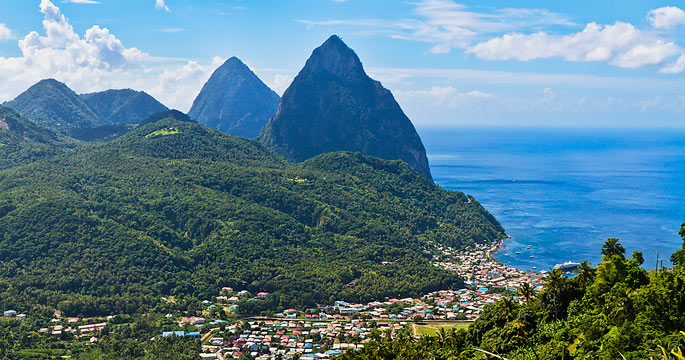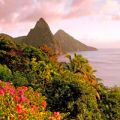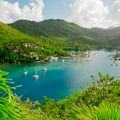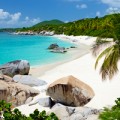When European explorers first glimpsed the lush green mountains of St. Lucia rising from the cerulean waters of the Caribbean, they nicknamed the island “Fair Helen of the West Indies,” making reference to the unrivaled beauty of legendary Helen of Troy. Today, this jewel of the Windward Islands epitomizes the Caribbean island escape, with warm palm-fringed beaches to relax, colorful coral reefs to discover, forests to explore, mountains to climb and waterfalls to admire.
1 Twin Peaks
The Pitons are St. Lucia best-known landmarks. This pair of iconic mountains, known as Gros Piton and Petite Piton, rises above Anse Chastanet Beach, and is the most photographed site on the island. The remnants of volcanic eruptions more than 30,000 years ago, the pitons are now covered in green vegetation. They provide ambience and a backdrop for weddings and honeymooners, and challenging routes for hikers.
2 Favorite Subjects
The forested mountains, seaside villages and sparkling bays of St. Lucia are postcard pretty, and have been highlighted in movies from Dr. Doolittle to Pirates of the Caribbean. Photographers from around the world also turn their focus to subjects such as the villages of Marigot Bay and Anse La Raye, where colorful fishing boats and anchored yachts add color and interest to the natural beauty of the scene.
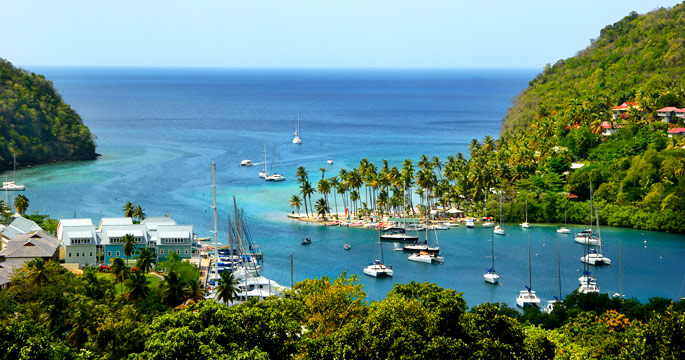
Encircling hills create a calm, perfectly protected anchorage at Marigot Bay, which attracts visiting sailors and gleaming mega yachts alike. Photo: Robert Rushton/iStock
3 Sight Seeing
The mountain roads that wind their way across St. Lucia unveil one spectacular view after the next. Along the coast, the scene includes bright beaches, tranquil coves and quaint seaside villages. Near Soufrière, the Pitons provide a magnificent backdrop against the cobalt sky, while inland roads lead to jungle- clad valleys and rivers. The views grace every hairpin turn and postcard-worthy shots pass by one after the next.
4 Beach Variety
From golden tan to volcanic dark grey, the beaches of St. Lucia come in a wide range in colors. For the typical white sand beaches head to the southern coast of Anse Des Sables. Warmer beige and gold tones are found in Rodney Bay at Reduit Beach and the connected peninsula of Pigeon Island, which is a 40-acre national park. The black and gray sands of Anse Cochon provide a dramatic contrast to the bright coral reefs just offshore.
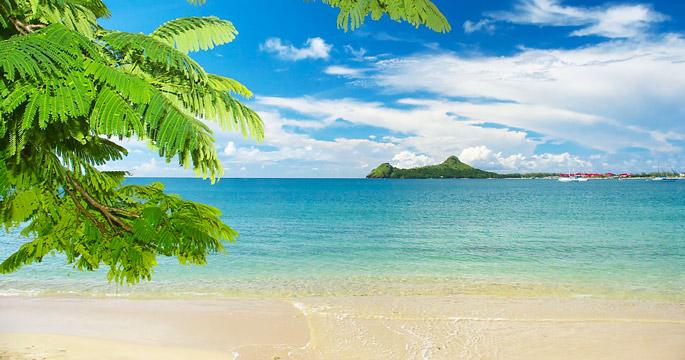
Reduit Beach is one of St. Lucia’s most popular places for swimming and sunning, with easy parking, public restrooms and beachside food and beverage vendors. Photo: iStock
5 Rooms with Views
Some of the world’s most amazing resorts cling to the hillsides of St. Lucia. Some are even built into the mountainside and hang over the beaches below. These venues exude seclusion and romance, with private pools, outdoor showers and rooms that open to nature. Suites at Jade Mountain provide private infinity- edge pools that seem to dissolve into the Caribbean below. Boucan sits in the middle of a cocoa plantation. Ladera has a quirky appeal and rooms with the fourth wall left open to nature, while Sugar Beach’s British Colonial-styled villas sit above a white sand beach. All provide the highest level of service and unrivaled views of the Pitons.
6 Amazing Waterscapes
St. Lucia’s rugged mountain landscapes continue underwater, providing divers with dramatic reefs and slopes carved by canyons, caves and deep drop offs. Near Anse Chastanet, the Soufrière Marine Park reveals underwater grottoes and fields of brain coral rich in tropical fish. Nearby, coral-encrusted pinnacles rise from the depths, and a subsea fumarole creates champagne- like gas bubbles that filter up through the reef.
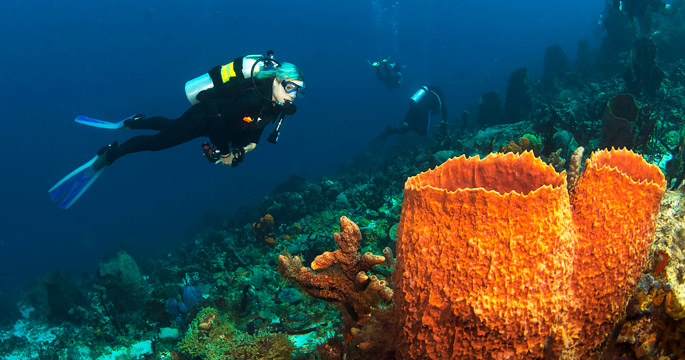
Divers examine a colorful sponge on a St. Lucia coral reef. The island’s western shore provides consistently clear, calm waters. Photo: Kevin Panizza/iStock
7 Friday Fries
The Friday evening fish fry is a celebrated island tradition, and there are two places to get your fill of golden-fried fillets served with a heady dose of local flavor. At the small fishing village of Anse La Raye, reggae music fills the air as crowds in a celebratory mood clutch brimming plates of snapper, lobster and conch. At Rodney Bay, the mood can get rowdy at Gros Islet’s Jump Up. Some come for the seafood, others come to party and dance in the streets until early morning. For a quieter local spot, Dennery fishing village sets up tents on the beach and vendors cook up an array of seafood for the neighborhood and whoever comes by.
8 Crafty Markets
Barter and bargain for authentic island flavors and handicrafts at one of two colorful market squares in the towns of Soufrière and Castries. Soufrière’s main square leads to the waterfront market where vendors sell root vegetables, an island staple, and offer visitors a taste of coconut water right from the husk. Castries market is the place to pick up spices, souvenirs, woodcarvings, and find a local spot for lunch.
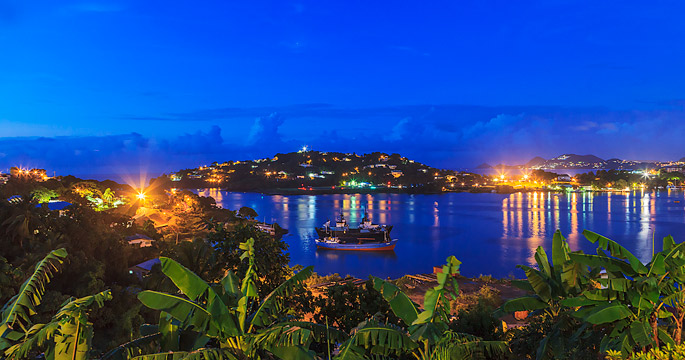
The lights of Castries Harbor sparkle in evening light. This lively harbor city is one of the region’s busiest nautical crossroads. Photo: Flavio Vallenari/iStock
9 For The Birds
While a number of new hotels and golf courses have come to the island in the past decade, much of St. Lucia remains in a natural state and many resorts promote nature tours, hiking and bird watching. The national bird, the St. Lucian parrot is making a comeback due to conservation efforts. Other noted finds include the St. Lucian oriole, warbler and white-breasted thrasher, along with the Antillean crested hummingbird.
10 Waterfalls
St. Lucia’s streams and rivers spill from the highlands to create sparkling cascades. The most visited waterfall is Diamond Falls at Diamond Botanical Gardens, which has been in the same family since 1713. Also near the Pitons and Soufrière is one of the islands largest falls, Toraille Waterfalls. For bathing in warm spring waters the shorter Piton Falls is a popular stop.

